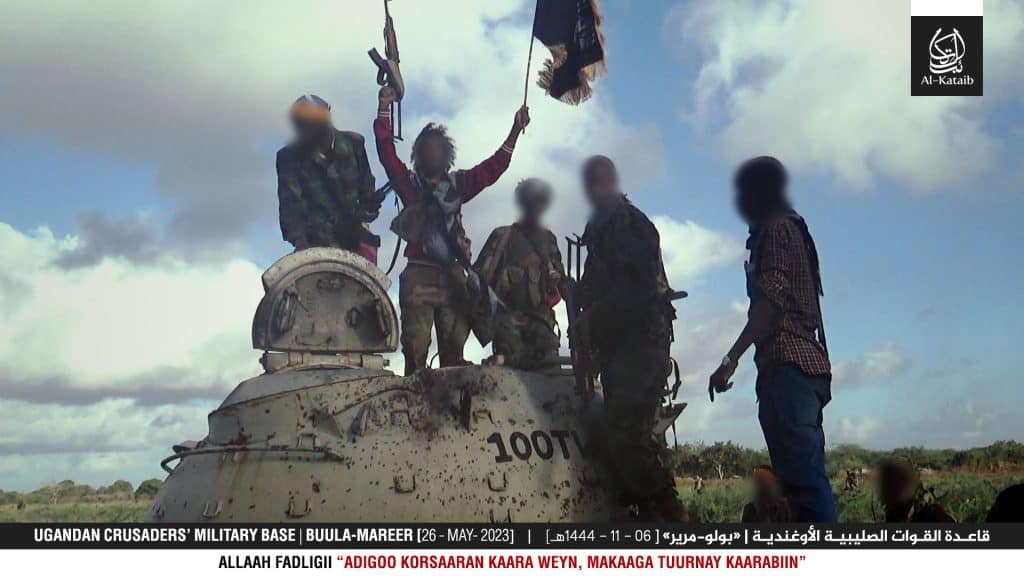
Shabaab, al-Qaeda’s branch in East Africa, briefly overran a Ugandan military base in Somalia’s Lower Shabelle yesterday. Though the African Union Transition Mission in Somalia (ATMIS) – of which Uganda is a constituent member – has confirmed the assault, it has so far not confirmed any casualties while also denying the base was overran.
Early yesterday morning, at least three suicide car bombs were launched at the Ugandan Peoples’ Defense Force (UPDF) base in Buulo Mareer, Lower Shabelle. Following the initial blasts, hundreds of Shabaab’s men then stormed the base, prompting an intense firefight. Local residents reported hearing severe gunfire and explosions throughout the morning.
Not long after, local residents of Buulo Mareer also reported that Shabaab briefly took control over the town itself, patrolling through the streets and looting local Somali military posts in the town after assaulting the base.
For its part, Shabaab confirmed using multiple suicide car bombs in the raid while also claiming to have killed over 130 UPDF troops in the base in addition to capturing two others alive. This number has not been confirmed by any other source. Shabaab does routinely inflate total fatality numbers, though it has been accurate on major attacks in the past.
Photos released by Shabaab, however, do show over a dozen killed Ugandan soldiers and two others in the process of being captured. Other pictures show complete destruction of the base, including tanks, armored vehicles, reinforced positions, and other areas of the base.
Shabaab has now successfully utilized or attempted at least 22 suicide bombings so far this year, according to data compiled by FDD’s Long War Journal.
Neither Uganda nor ATMIS has confirmed any casualties from the attack. Both, however, have indeed confirmed the assault took place, with Uganda saying it was probing the attack and ATMIS later saying the assault was repelled. Ugandan Lt. General Kayanja Muhanga, the overall Commander of Land Forces for the UPDF, was sent to Somalia as part of Uganda’s investigations in the assault.
Yesterday’s assault was the first major raid on an ATMIS base since last year’s attack on a Burundian outpost in Middle Shabelle. In that assault, dozens of Burundian troops were killed after Shabaab overran that base. At the time, Shabaab claimed at least 173 Burundian soldiers were killed, though the real number was still high, it was much lower than the claimed total.
The two assaults mimic Shabaab’s 2016 raid at El-Adde in Somalia’s southern Gedo region. That suicide assault left between 141 and 200 Kenyan troops dead. Kenya has rejected these numbers, however.
Similarly in Jan. 2017, Kenya lost an additional 68 troops in another large suicide assault conducted by Shabaab against one of Kenya’s bases in southern Somalia. And in Aug. 2018, at least 46 Ugandan troops were killed by Shabaab in a suicide assault involving two car bombs on an AU base in Lower Shabelle.
A recent report from Voice of America found that at least 3,500 African Union troops have been killed inside Somalia battling Shabaab since 2007, with some quoted officials holding the possibility that this number could be higher. The vast majority of killed troops have been from Uganda and Burundi.
Shabaab’s raid comes as the United States launched its eighth drone strike of the year in Somalia, targeting Maalim Osman, the head of Shabaab’s external operations wing, on May 20.
And just earlier this week, the U.S. State Department and U.S. Treasury Department placed sanctions on over 30 Shabaab commanders and financiers as part of efforts to help support the Somali government’s current offensives against Shabaab.
Somalia is currently waiting to officially start the second phase of its offensive against Shabaab, this time focusing on the al Qaeda branch in Jubaland and Southwest State. Militias loyal to Jubaland state have previously conducted anti-Shabaab operations in recent months.
Though Somalia benefited from clan hostility against Shabaab during the offensive’s first phase in central Somalia, it is unclear how well it can benefit from anti-Shabaab clan sentiment in Somalia’s south, where Shabaab has based much of its governance and social services. Additional troops from Djibouti, Kenyam and Ethiopia, which will be outside of African Union control, are slated to deploy to Somalia to help assist the federal forces in this endeavor.
For its part, Jubaland has so far rejected overtures from the federal government to replicate the clan model it utilized in Somalia’s center – though the rejection was largely based on intra-Somali political rivalries than any sense of futility regarding Shabaab’s strong relations with the southern clans.
Though its fortunes have ebbed and flowed over the past decade, it has also weathered numerous offensives from an array of local, regional, and international actors, including the United States.
It is now facing its largest challenge in over a decade, though if yesterday’s large assault is any indication, the fight against Shabaab is far from over.







